“There is no detective in England equal to a spinster lady of uncertain age with plenty of time on her hands.”
Agatha Christie, The Murder at the Vicarage
Who is Miss Jane Marple?
Elderly spinster, Miss Jane Marple, lives in the fictional village of St. Mary Mead, where she uses her keen understanding of human nature and observation to solve puzzles and crimes. She is described as a fluffy old pussy by people who don’t know her and the winged avenger, Nemesis, by her confidantes. Miss Marple is a force no criminal would want to cross. Her hobbies include gardening, knitting, which allows her to keep a close eye on her fellow villagers, and travel which often reaffirms her worldview that people are much alike wherever. Despite being described as a busybody, she has many friends and is frequently visited or gifted trips by her nephew, Raymond West, a famous author. While she is somewhat bewildered by Raymond’s cynicism and snobbishness, she loves him dearly. An economic woman who treats her servant girls well and her peers with unflinching practicality. Modest, like many older women of her time, but not prudish, she goes unflinchingly into the dark recesses of human nature to uproot evil doers so the rest of her community can flourish.
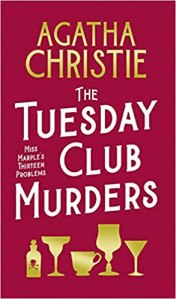
In the December 1927 issue of The Royal Magazine, Jane Marple first appeared in the short story “The Tuesday Night Club.” In her initial story, Miss Marple has invited over her fellow club members who weekly discuss an actual murder. On this particular occasion, Miss Marple’s friend, Sir Henry Clithering, recounts how Mr. and Mrs. Jones and Mrs. Jones’ companion, Miss Clark, all contracted food poisoning after dinner. After Mrs. Jones died, there was so much malicious gossip about her peculiar death that her body was exhumed, and the autopsy revealed she was poisoned with arsenic. Sir Henry Clithering and their fellow guests discuss the possibilities of who the murderer could be while Miss Marple is silent. Once the others have exhausted their theories, Sir Henry Clithering asks Miss Maple her theory. She methodically outlines how it was done by pointing out similar behaviors by the residents of St. Mary Mead. Stunned by her tactics, the rest of the group is horrified to discover she is correct.
“The Tuesday Murder Club” story establishes the foundational formula of her books: overlooked by the present company. Miss Marple insinuates herself in the mystery; she looks for behavior similar to the people of St. Mary Mead and can extrapolate the evil doings from her knowledge of people. Several guests, such as Sir Henry Clithering and Miss Marple’s nephew, Raymond West, appear in her future novels.
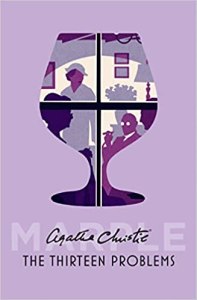
“The Tuesday Night Club” short story later became the first chapter of The Thirteen Problems, a collection of early short stories written by Agatha Christie starring Miss Marple. However, it was Miss Marple’s first full-length novel, The Murder at the Vicarage, published in 1930, that explored the evil that pulsates beneath the surface of Miss Marple’s village of St. Mary Mead. Like Miss Marple, appearances can be deceiving.
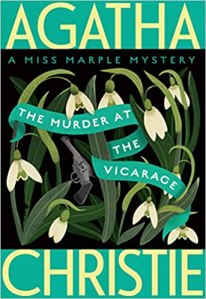
The Murder at the Vicarage by Agatha Christie (Miss Marple Mysteries, 1)
The Players
- Miss Jane Marple: An elderly spinster with a keen eye and a deep sense of human nature. Her curiosity and shrewdness solve the case of Colonel Protheroe’s death.
- Colonel Lucius Protheroe: A blustery man who rules his family with an iron fist. Unhappily married to his young wife, Ann Protheroe. Father to Lettice Protheroe, with whom he quarrels. He is currently investigating some financial irregularities in the church’s financial accounts.
- Ann Protheroe: Colonel Protheroe’s much younger wife. She is rumored to be having an affair with Lawrence Redding, who is painting her portrait.
- Lettice Protheroe: Colonel Protheroe’s flirtatious teen daughter. She finds her father tiresome and resents her stepmother, Ann. She enjoys flirting with Lawrence Redding, who is also painting her portrait.
- Leonard Clement: The local vicar in whose study Colonel Protheroe dies before their meeting to go over the financial irregularities.
- Griselda Clement: Leonard Clements young vivacious wife. She loves tea, scandal, and beautiful clothes.
- Mary Adams: The Clements’ terrible cook and housemaid. She is dating Bill Archer.
- Mr. Hawes: The new curate in St. Mary Mead. Constantly ill, nervous, and under strain.
- Doctor Haydock: The village general practitioner. When he fixes the time of Colonel Protheroe’s death, the whole murder case is blown apart. Seemingly knows Mrs. Estelle Lestrange.
- Lawrence Redding: A handsome young artist painting several women in the village of St. Mary Mead.
- Mrs. Estelle Lestrange: A mysterious and elegant stranger to St. Mary Mead who has a past with Colonel Protheroe that she would like to keep secret.
- Bill Archer: Recently sentenced by Colonel Protheroe to a harsh prison for poaching. Mary Adam’s boyfriend.
- Inspector Slack: An arrogant and imperious police inspector tasked with investigating the death of Colonel Protheroe.
- Colonel Melchett: The senior officer investigating Colonel Protheroe’s death.
- Doctor. Stone: An archeologist working on a barrow on Colonel Protheroe’s estate.
- Gladys Cram: Doctor Stone’s assistant. The village ladies believe she wishes to marry Doctor Stone.
The Mystery
The Reverend Leonard Clement is going about his usual daily tasks and lives in a happy home with his much younger wife, Griselda. They offer to host a tea at their home and invite local “old pussies” Caroline Weatherby, Amanda Hartnett, Martha Price-Ridley, and Miss Jane Marple. The group gossip about the new resident and the reticent Miss Lestrange’s mysterious past before discussing the intrigues around Lawrence Redding. Lawrence is a visiting painter who is currently working on portraits of Lettice Protheroe and her stepmother Ann Protheroe. The old ladies suspect he is having an affair with one of them but are undecided about his true affiliations. Reverend Clement cautions the women that their bit of fun banter while entertaining can cause actual harm.
Reverend Clement finds that the gossipy old ladies are correct when he goes to the shed on the Vicarage property to see the portrait Lawrence Redding is painting of his wife, Griselda, but instead finds Lawrence Redding and Ann Protheroe in the throes of passion. Embarrassed, Reverend Clement quickly leaves but is met at the vicarage later by a distraught Lawrence Redding, who pleases with Reverend Clement not to reveal their affair to the Colonel. Lawrence Redding tries to convince Reverend Clement that he and Ann Protheroe are genuinely in love. Still, Reverend Clement kindly advises Lawrence Redding to leave St. Mary Mead because nothing good will come from this affair. Reverend Clement warns Lawrence Redding that he has until the next day to decide about ending the affair because Colonel Protheroe is meeting Reverend Clement at the vicarage to review the financial accounts. If the romance isn’t finished, he will reveal the affair.
The next day, Reverend Clement receives a call that an older man who has been sick for a long time is requesting his presence. When Reverend Clements bicycles to the man’s house at the far end of the village, he finds that no one ever called him. Confused, he bicycles back to the vicarage to go over the parish accounts because Colonel Protheroe has been told that some of the more significant donations to the church are not be reported. He suspects someone is stealing from the church accounts.
When Reverend Clement returns to the vicarage, he meets a hysterical Lawrence Redding coming down the path away from the vicarage. When Reverend Clement steps inside his study, he is met with Colonel Protheroe slumped over his writing desk with a note tucked under his body and a bullet hole in his skull.
The police investigation led by Colonel Melchett and seconded by Inspector Slack is confounded by a discrepancy between the time of death given by Doctor Haydock at 6:40 pm and the note pinned under Colonel Protheroe stating the time to be 6:20 pm. The 6:20 pm evidence is seemingly upheld with the study clock being smashed at 6:20 pm. When Reverend Clement is questioned about the discrepancy, he neglects to tell Inspector Slack that the clock is set fast because the Inspector rudely bulldozes over whatever Reverend Clement says.
Inspector Slack soon fastens on the idea that Mary Adams, the only other person in the vicarage, might be involved but finds her motive-that the judge sentenced her boyfriend Bill Archer for poaching harshly. Mary mentions that she heard a funny-sounding gunshot in the woods nearby but thought little of it. When Inspector Slack questions others about the shot, they agree with Mary’s account that it came from the woods and not the vicarage. Inspector Slack dismisses his theory that Mary was involved and starts to scrutinize Lawrence Redding’s account of Colonel Protheroe’s death.
Lawrence Redding confesses to killing Colonel Protheroe to save Ann Protheroe from a loveless life. However, his account gives an inaccurate time of death, and he is exonerated. When pressed, he says he is covering for Ann Protheroe, who must have killed her husband to keep their affair secret.
When Ann Protheroe is questioned about her husband’s death, she confesses to killing him, but since she was seen entering the vicarage without a purse and a gun by Miss Marple, her confession is deemed worthless. Upon further questioning, she admits she was covering for Lawrence Redding.
Inspector Slack, looking for other possible suspects, catches wind of Mrs. Lestrange’s hostile visit to Colonel Protheroe when his wife and daughter are absent from the house. When asked to explain her movements to the police, she refuses and is arrested.
While Inspector Slack is busy with Mrs. Lestrange, Miss Marple lists her suspects and starts working on eliminating the innocent. First on her list is Miss Cram, who she sees going into the woods at midnight to bury a suitcase; she tells Reverend Clement of this strange occurrence, and he later finds where she buried it. While looking for Miss Cram’s concealed bag, Reverend Clement also finds a small crystal of picric acid, an explosive. Miss Marple and the Reverend open the suitcase to see it full of valuable silver from the Protheroe, which had been stolen by Doctor Stone, the archeologist working on the barrow on the Protheroe’s land. When confronted, Miss Cram knows nothing about the silver heist and works with Miss Marple to uncover that the Doctor Stone she has been working with is an imposter- and a thief! Having replaced the real silver with replicas, the fake Doctor Stone fled, but it’s unlikely he killed the colonel.
Overcome, Reverend Clement delivers a fiery speech to his parishioners on the pervasive evil happening in the village. Curate Hawes, ill and nearly mad, tells the Reverend that he has something to confess. When Reverend Clement he finds Hawes dying from an overdose and Colonel Protheroe’s genuine note by his body. When the Reverend attempts to call Doctor Haydock, he accidentally connects with Miss Marple, who finally understands the truth.
The Motives
Bombastic Colonel Protheroe creates resentment wherever he roams. His younger wife, Ann Protheroe, finds him boorish and challenging to be around and admits that she married him after the Great War for security. Ann Protheroe is no longer in love and unfulfilled, but she finds passion with romantic ne’re do well painter Lawrence Redding. Without her husband, they could marry, and she could leave her vague disagreeable stepdaughter Lettice Protheroe behind.
Lettice Protheroe resents her father’s boorish attempts to control her. She acts out by shamelessly flirting with Lawrence Redding, who she knows her father dislikes. Whether she is genuinely infatuated with Redding is challenging, but Letticee doesn’t need to love him to irritate her father. With her father dead, she has the autonomy to spend money as she likes, flirt with whomever she desires, and as the primary beneficiary of her father’s estate, she can throw out her step-mother, Ann Protheroe, who she suspects is unfaithful to her father.
Lawrence Redding has a lot to lose if old Colonel Protheroe turns his attention from parish accounts and investigates the true nature of his relationships with Anne Protheroe or Lettice Protheroe. His affair with Ann and his risque painting of Lettice in a bathing suit will indeed cause the colonel to go apoplectic. Does Lawrence Redding love Ann or care enough about one unfinished painting to shoot a man? He could be like moss on a rolling stone and leave of his own will without harming anyone.
Mr. Hawes, a newcomer to the parish ministry, needs to be more relaxed and chronically stressed. Ill at ease and unwell, he flies into a panic when Colonel Protheroe, a churchwarden, wants to see Hawes’ financial accounts when some charity donation money appears to be missing. Mr. Hawes has been skimming off the top for an unknown reason, and if he’s unmasked, is he desperate enough to kill Colonel Protheroe?
The alluring and intensely private Mrs. Estelle Lestrange is a newcomer to St. Mary Mead. She avails none of her secrets to the gossipy old ladies of the village and trusts no one except Dr. Haydock. The villagers are surprised to learn that she has a sordid past with Colonel Protheroe and visited him before he was killed. While deciding whether to unburden herself about their shared history, she is arrested for Colonel Protheroe’s murder.
However, it might not be the Colonel’s past that motivates his untimely demise but his present. When he, in his capacity as judge, sentences Bill Archer, a poacher, to a stiff penalty, he incurs not only Archer’s wrath but that of Archer’s girlfriend, Mary Adams- the only other known person in the vicarage while Colonel Protheroe was waiting for his meeting with Leonard Clement.
The Verdict
With motives abounding on every page, there’s a lot for the reader to sink their teeth into. A rich interplay of characters and lots of secrets waiting to be unveiled, it’s engaging and climactic throughout the story. From the start, you know the sort of man Colonel Protheroe is- loud, controlling, oblivious, and having power in all spheres of his life that he uses to bully people below him in the social order. When he is found shot in the back of his skull with the clock supposedly giving an accurate time of death, this looks like a straightforward case, especially with Lawrence Redding being seen leaving the vicarage and confessing to the murder. However, as Inspector Slack digs into the matter, nothing is as simple as it appears.
What begins as a simple case of a love triangle gone to the worst possible conclusion soon becomes a confluence of alibies and misdirections to account for the missing 20 minutes between when the clock was smashed at 6:20 pm, and Colonel Protheroe was shot at 6:40 pm. When the clock is revealed to be set 10 minutes fast, the time of death narrows between 6:30-6:40 pm, and if the Colonel was waiting only a short period, why did he write such a strange note to Leonard Clement about his long wait? These mysteries cloud and muddle the plan for Ann Protheroe and Lawrence Redding to work together to commit the crime. Indeed partnered in every sense, Lawrence hides the gun in the study for Ann to find. Ann quickly shoots her husband with a silencer, and Lawrence returns later and reveals that he killed the colonel to remove suspicion from Ann. They cover their tracks by setting off a shot in the woods, so the gunshot time would further complicate discovering who killed the colonel.
This is for people who like the journey of unraveling the mystery. If you want a creative or hidden motive, this isn’t going to tick that box. The most obvious motivation is the true one. What makes this a more enjoyable story is the lengths they go to throw suspicion off of themselves and fool almost everyone.
Another standout part of this book is the world-building of St. Mary Mead. Agatha Christie provides a hand-drawn map of the village, and we visit every place on the map from multiple points of view to get first-hand knowledge of what we see and what the other villagers can see. It’s a fishbowl and provides a profoundly claustrophobic feeling to the book. Living in St. Mary Mead means only a level of privacy if you go to great lengths to avoid being seen. Besides providing an atmosphere, It’s a closed-circle mystery. Still, instead of a boat or a country manor, it’s an entire village whose people cannot leave, and with every action, they cause a reaction, some within the bounds of strict English social hierarchy and some not.The Murder at the Vicarage is an excellent first taste of Miss Marple, St. Mary Mead, and the world of the Miss Marple series. I invite everyone to read or re-read this worthy, if somewhat overstuffed, book. There are too many subplots, but I like them and don’t want any of them cut from the story. The Murder at the Vicarage is a feast so go into the story hungry.
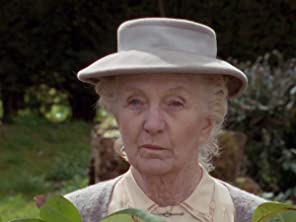
Miss Marple (1986) with Joan Hickson
Of the two televised versions of this story, this one is a better adaptation of the novel due to the trimming of the fatty subplots. Doctor Stone and Gladys Cram are omitted entirely, as well as the superfluous Colonel Melchett, so Inspector slack does all the investigating. Several minor characters are stricken from the story to focus on the central mystery: who killed Colonel Protheroe and how Jane Marple will figure it out. At the outset, this seems the way to go about it. It’s admittedly laden with characters and subplots, according to Christie. Yet, it’s a bland serviceable re-enactment of the story with most of the joylessness lading squarely on Joan Hickson’s shoulders. She lacks any Joie de Vivre in her role and does not relish the gossipy nature of Jane Marple in this story before it’s tamped down in other stories. Her quivering, matter-of-fact voice is straight to the point like Marple’s but lacks any wisdom or understanding of how murderers have fallen due to their folly. In the original stories, Miss Marple knows the destructive nature of man’s folly. She does not envy her fellow humans for falling into its trap, just maybe a trifle saddened by their fate; Joan Hickson sounds bored and, occasionally, when her hackles are up: condescending. It’s not a performance that lends to repeated viewing.
However, I enjoy the changes to the story, the streamlining of the cumbersome plot, and the revamping of ridiculous notions of the novel-I’m looking at you boulder in the woods triggering the shot- and replacing it with a more logical and plausible way things happened. More focused on fixing the squidgy mechanics than embroidering the story means it holds up well to repeat viewings, especially if you like to see how the crime is done.

Agatha Christie’s Marple (2004) with Geraldine McEwan
Booked with an additional subplot about Jane Marple’s sweetheart going to war, this adaptation is straightforward and will take artistic liberties with the story. This is a strange choice in a tale overstuffed with characters and subplots. Also, I only need Jane Marple’s backstory expounded upon with any text or subtext by Agatha Christie or her intensive notes. There is also the equally puzzling decision to write another subplot in which Colonel Protheroe stole 10,000 francs from the french resistance, ensuring the death of an agent. While probably emotionally charged for the British viewers, it feels too far from the claustrophobic and high-stakes relationships in a sleepy English village. To bolster this inane storyline, the characters of Mrs. Cram and Dr. Stone are rewritten as an elderly French professor and his granddaughter. Maybe they didn’t want to engage in the tired trope of a young woman trying to trap an older man into marriage, but there are ways to update that and still be faithful to the spirit of the original story.
So, after all my complaining, I must hate this adaptation, and…no, it’s excellent. Geraldine McEwan is a pitch-perfect Jane Marple. Warm and friendly and as penetrating as her knitting needles, when Jane Marple checks out that the whole crime has been a parade of deception and obfuscation from its inception, it’s easy to believe her account. The setting is lovely and doesn’t look like a set, a lot, or a studio. It feels natural, aided by characters bicycling and walking to locations, lots of well-done establishing shots, and a stellar place. Protheroe is the blustering blowhard who manages to annoy in his first scene, Griselda is carefree without being ditzy, and the vicar, Leonard Clement, is friendly and disarming and sincerely cares about his community. It’s an excellent translation of the character’s qualities translated to the screen when hampered by Christie’s sparse character descriptions. Even though some of the window dressings with subplots and added backstories have been changed, the central mystery (save the type of gun) remains staid, which makes the whole episode a winner. The actual procedures necessary to complete such a murder are laid bare and don’t really live up to prolonged scrutiny, but still have plausibility. And who doesn’t want an audacious murder to have a dose of incredulity to make it more fantastical and further from the cruelty of the real thing? The story and the puzzle are the novel’s heart and are preserved in this adaptation. A good yarn and great acting make this a favorite series episode.
#MissMarpleMonthly February’s Pick is……………..
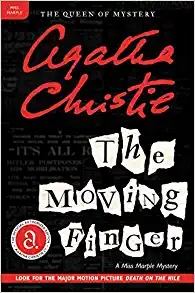
The Moving Finger by Agatha Christie (Miss Marple Mysteries, 4 and one of my favorite books in the series! On February 28th, 2023, join Miss Marple as she unravels who is sending poisoned pen letters to the residents of the country village of Lymstock. When a woman commits suicide due to the damning nature of the note she receives, the sleepy little town reckons with a cunning murderer. Please read this post if you’re wondering why we skipped over some books in the series.
Book Recommendations
If you still haven’t had enough of Miss Marple, I recommend the second book in the Miss Marple series, The Body in the Library. When the body of a dead young woman is found on the hearth rug in the Bantry’s library, nobody can figure out how she got there. As Miss Marple studies her prone body, she notices her bitten fingernails, and this tiny clue begins to unravel the whole plot.
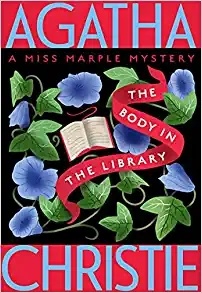
For those of you that have read the Miss Marple series again and again, I recommend MARPLE: 12 New Mysteries. Twelve new short stories featuring Miss Marple by some of the best modern mystery writers. Writers include Lucy Foley (The Guest List, The Hunting Party), Val McDermid (Out of Bounds), and Ruth Ware (The It Girl), among others. Join Miss Marple as she helps solve “A Second Murder at the Vicarage” or visits New York City to see a broadway show and helps catch a killer before the curtain call. With appearances from all of your favorite characters from the Miss Marple mythos, this will surely delight avid readers of the Miss Marple series.
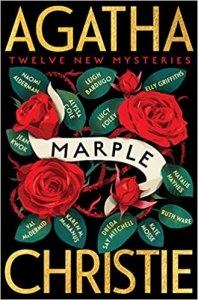
For those who would like to read the authorized biography of Jane Marple, look no further than Anne Hart’s 2019 magnum opus Agatha Christie’s Miss Marple: The Life and Times of Miss Jane Marple. This biographical work, approved by Agatha Christie’s daughter, Rosalind Hicks, collates all of the facts of Miss Maple’s life over the twelve novels and twenty short stories in which she appeared. Bolstered by information from newspapers, original publishing articles, and magazine serials, this is the definitive guide to the woman who is Miss Marple. With updated lists of tv, radio, and stage productions, this compendium will surely help you find how to enjoy her stories in whatever medium you love the most.

Thank you for joining me this month to discuss The Murder at the Vicarage. I can’t wait until February 28th so we can dissect The Moving Finger. Let me know your thoughts about The Murder at the Vicarage below!





Leave a comment